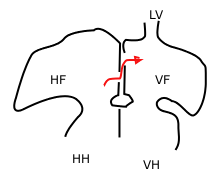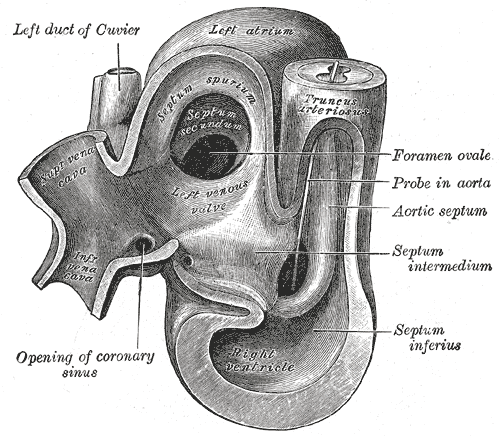Foramen ovale (heart)
Editor-In-Chief: C. Michael Gibson, M.S., M.D. [1]
Associate Editors-In-Chief: Priyamvada Singh, MBBS [[2]]
Assistant Editor-In-Chief: Kristin Feeney, B.S. [[3]]
Overview
In the fetal heart, the foramen ovale (or ostium secundum of Born) allows blood to enter the left atrium from the right atrium. It is one of two shunts, the other being the ductus arteriosus, that allows blood entering the right atrium to bypass the pulmonary circulation. Another similar adaptation in the fetus is the ductus venosus. In most individuals, the foramen ovale closes within the first year after birth to form the fossa ovalis.
Development
The foramen ovale begins forming late in the fourth week of gestation. Initially the atria are separated from one another by the septum primum except for a small opening in the septum, the ostium primum. As the septum primum grows, the ostium primum narrows and eventually closes. Before it does so, bloodflow from the inferior vena cava wears down a portion of the septum primum, forming the ostium secundum. Some embryologists postulate that the ostium secundum may be formed through programmed cell death. The ostium secundum provides communication between the atria after the ostium primum closes completely. Subsequently, a second wall of tissue, the septum secundum, grows over the ostium secundum in the right atrium. Bloodflow then only passes from the right to left atrium by way of a small passageway in the septum secundum and then through the ostium secundum. This passageway is called the foramen ovale.
Closure
Normally this opening closes in the first year of life. When the lungs become functional at birth, the pulmonary pressure decreases and the left atrial pressure exceeds that of the right. This forces the septum primum against the septum secundum, functionally closing the foramen ovale. In time the septa eventually fuse, leaving a remnant of the foramen ovale, the fossa ovalis.
Clinical Relevance
Patent foramen ovale
In about 30% of adults the foramen ovale does not close completely, but remains as a small patent foramen ovale. People with a patent foramen ovale are more likely to suffer from migraine headaches. Corrective surgery often results in the complete cessation of migraines in some patients, and a greater than 50% reduction in migraines on average [4].
Anatomy
-
Sketch showing foramen ovale in a fetal heart. Red arrow shows blood from the inferior caval vein. HV: right atrium, VF: left atrium. HH og VH: right and left ventricle. The heart still has a common pulmonary vein (LV), in stead of four.
-
Heart of human embryo of about thirty-five days, opened on right side.

